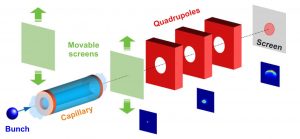The active-plasma lens consists of a neutral gas confined in a narrow structure like a capillary. The gas is then ionized into a plasma by a current-discharge flowing through the capillary itself. According to the Ampère law, the discharge induces an azimuthal magnetic field whose strength is directly proportional to the flowing current. As a reference, a 100 A current flowing into a 100 μm hole diameter capillary is able to generate magnetic gradients as large as 1 kT/m, i.e. approximately one order of magnitude larger than the strongest available quadrupoles. Such a magnetic field can then be used to focus particle beams and replace conventional devices (like solenoids and quadrupoles) with more compact structures.

Schematic setup of plasma lens at SPARC_LAB. Movable screens can be inserted in different positions to measure the beam dimension. A triplet of permanent quadrupoles can also be inserted to recollimate the beam after the capillary.
The SPARC_LAB team has developed an active-plasma lens consisting of a 3 cm-long capillary with 1 mm hole diameter. The plasma is produced by ionizing hydrogen gas with a 20 kV discharge. The experimental setup has been installed at the end of the SPARC linac and the first tests started in 2016. At that time the main finding was the observation of a strong degradation of the beam emittance [R. Pompili et al., A. Marocchino et al.]. Such an effect limited the overall beam focusing to minimum spot sizes of 24 μm. Further tests and theoretical investigations determined that such a behavior was mainly due to non-uniformities on the plasma when driven by low currents (~100 A). With the aim to overcome such a limit, the peak current has been increased up to 230 A by developing a new discharge pulser. With the new setup, the data acquired at the end of 2017 proved that a better focusing was achieved (17 μm spot sizes) and emittance preserved downstream the plasma lens [R. Pompili et al.].
These results represent a fundamental step toward the development of next-generation focusing optics and demonstrate their effective usability in view of new compact facilities.
Publication Highlights:
- “Experimental characterization of active plasma lensing for electron beams “, R. Pompili, et al., Applied Physics Letters vol. 110 (2017) pag. 104101, doi: 10.1063/1.4977894
- “Experimental characterization of the effects induced by passive plasma lens on high brightness electron bunches”, A. Marocchino et al., Applied Physics Letters vol. 111 (2017) pag. 184101, doi: 10.1063/1.4999010
- “Focusing of High-Brightness Electron Beams with Active-Plasma Lenses”, R. Pompili et al., Phys. Rev. Lett. vol. 121 (2018) pag. 174801, doi: 10.1103/PhysRevLett.121.174801
- “Acceleration and focusing of relativistic electron beams in a compact plasma device”, R. Pompili et al., Phys. Rev. E vol. 109 (2024) pag. 055202, doi: 10.1103/PhysRevE.109.055202
- “Guiding of Charged Particle Beams in Curved Plasma-Discharge Capillaries”, R. Pompili et al., Phys. Rev. Lett. vol. 132 (2024) pag. 215001, doi: 10.1103/PhysRevLett.132.215001
Plasma experiments

